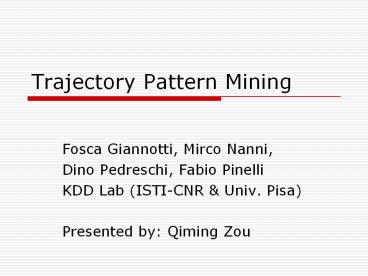Trajectory Pattern Mining - PowerPoint PPT Presentation
Title:
Trajectory Pattern Mining
Description:
We can extract information and patterns from these data to describe mobility behaviors ... Usage-based (popular places) Mixed (popular squares) Future Work ... – PowerPoint PPT presentation
Number of Views:96
Avg rating:3.0/5.0
Title: Trajectory Pattern Mining
1
Trajectory Pattern Mining
- Fosca Giannotti, Mirco Nanni,
- Dino Pedreschi, Fabio Pinelli
- KDD Lab (ISTI-CNR Univ. Pisa)
- Presented by Qiming Zou
2
Overview
- Motivations
- Trajectory
- T-Pattern
- Regions of Interest
- Future Work
- QA
3
Motivations
- Large number of mobile devices, mobile services
available
4
Motivations
- It is possible to collect position traces from
such devices - We can extract information and patterns from
these data to describe mobility behaviors - Use this information for fields such as urban
planning
5
Trajectory
- Trajectories are sequences that contain the
spatial and temporal information about movements
6
Trajectory
- Trajectories are usually given as spatiotemporal
(ST) sequences - lt(x0, y0, t0), ..., (xn, yn, tn)gt
- xi, yi is the position coordinate relative to the
origin - ti is the time stamp for the position information
7
Trajectory
- 2D and 3D representation of a trajectory
8
T-Pattern
- A Trajectory Pattern (T-Pattern) is a couple (s,
a), where - s lt(x0, y0),..., (xn, yn)gt is a sequence of n1
locations - a lta1,..., angt are the transition times such
that ai ?ti ti ti-1
9
T-Pattern
- A T-Pattern Tp occurs in a trajectory if it
contains a subsequence S such that - each (xi, yi) in Tp matches a point (xi, yi) in
S - the transition times in Tp are similar to those
in S
10
T-Pattern
- The same exact spatial location (x, y) usually
never occurs - Yet, close locations often represent the same
place - The same exact transition times usually do not
occur often - However, close times often indicate similar
behavior
11
T-Pattern
- To solve the problem, we introduce the notions
of - Spatial neighborhood Two points match if one
falls within a spatial neighborhood N() of the
other - Temporal tolerance Two transition times match if
their temporal difference is t
12
T-Pattern
- Example
13
Regions of Interest
- It is too computational intensive and yield
little practical use to generate all T-Patterns - Solution Use a Regions of Interest approach,
only use these regions as nodes of the T-Patterns
14
Regions of Interest
- Given a set of Regions of Interest R, define the
neighborhood of (x, y) as - Neighbors belong to the same region
- Points in no region have no neighbors
15
Regions of Interest
- Slt(x0, y1, t1), ..., (x4, y4, t4)gt
- gt
- lt(R4, t0), (R3, t2), (R3, t3), (R1, t4)gt
16
Regions of Interest
- What if the Regions of Interests are not known
before hand? - Define heuristics for automatic Regions of
Interest extraction from data - Geography-based (crossroads)
- Usage-based (popular places)
- Mixed (popular squares)
17
Future Work
- Application-oriented tests on large, real
datasets - Study relations with
- Geographic background knowledge
- Privacy issues
- Reasoning on trajectories and patterns
18
Trajectory Pattern Mining
- Questions?































